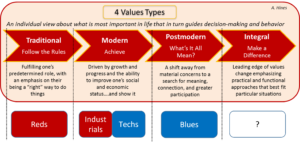Former Labor Secretary Robert Reich recently wrote about “Facing America’s Second Civil War.” While he sees it more as a voluntary zip code split into blue (urban) and red areas (rural and exurban) rather than a shooting war, this hardly offers us much comfort. It reinforced an observation from teaching a recent Certificate in Strategic Foresight class in which a participant questioned an example set of scenarios as biased. Everything in the US now, it seems, is interpreted through the Red or Blue lens. The Reds see anything they don’t like as an example of Blue bias, and vice versa.
 What’s going on here from a values perspective?
What’s going on here from a values perspective?
In ConsumerShift, drawing on the World Values Survey and Spiral Dynamics data, the long-term trend is a shift from traditional to modern to postmodern to integral values [see blog posts for basics on values). While the overlay is not 100% accurate, it is close enough to be useful to say that the Reds are mostly Traditionals, and the Blues are mostly Postmoderns. Their percentages in the US are roughly equal, in the mid-20s (it is very difficult to pin down the precise numbers). The long-term trends favor the Blues, as the postmodern cohort is growing and the traditional one is shrinking. I hope some of you are already asking, “what about the moderns ‘in-between’ the traditional and postmoderns?” Indeed, that’s the interesting question! You might say there is little to be done with the traditional reds and the postmoderns blues – each seems to be dug deeply into their positions and cannot tolerate the other. The moderns, if you will, could go either way. And if you look at US election results, they are evenly split as well! The long-term trends says they should be inching toward the postmoderns – but they ain’t there yet!
Let’s recall the moderns put a high value on competition, achievement, and growth. We actually have yet another fairly even split here: the “declining” industrial manufacturing base of the economy leans red and the “emerging” high-tech base leans blue. As an example, let’s say the construction industry leans red and cloud-based tech companies lean blue. Please know that I acknowledge the generalizations here.
[Quick aside]I’ve noted in the Tech-Led Abundance image from After Capitalism that modern values are a key driver, and I note here that this concerns me a bit. The “beating the other” ethos is not what we need in our positive long-term images and the hope here is that the Tech-Led Abundance image evolves over time toward integral values.
In sum, we have a fairly even split between the “poles” of traditional red and postmodern blue, that sandwich a middle of moderns who in turn are split between the industrial manufacturing red and the high-tech blue. The long-term trend says momentum favors the blue. But one side winning isn’t the answer. It’s a evolution toward integral values, which believe there is not “one right way.” Let’s hope we get there without too much damage along the way. – Andy Hines

Reich follows the seminal work of David Brooks and others in tracking what is at-heart a rural-urban split that has always been a feature of American political economic interests. A rich source for understanding political behavior world wide, for instance, in understanding Mao’s successful peasants revolution, it goes to deep resentment of urban elite value systems that are marked by social progressivism and secularism; seen in rural cultures as threatening traditional social order and scriptural values. That we are now aware and galvanized politically along these faults lines might be with us for quite some time.